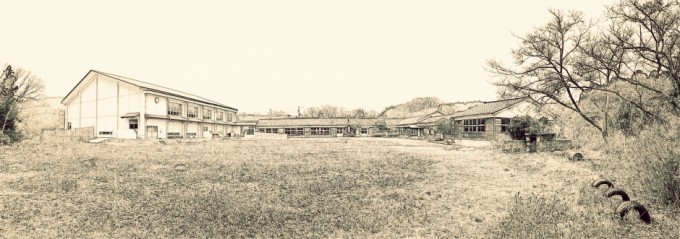“The Fukaura Schoolhouse” by Johnny Wales
Fukaura Gakusha – The Fukaura Schoolhouse
by Johnny Wales

Welcome to Fukaura Gakusha (Fukaura Schoolhouse)
Not far from Kodo Village and perched high on the same ridge on Sado’s southern-most coast is the Fukaura Schoolhouse. This is where the first generation of Kodo members’ own children went to elementary and middle school, so it holds a special place in our hearts. Sadly, three years ago – as in so many other places in the Japanese countryside – it closed due to lack of young people to fill up its desks. Just a 15-minute walk down the road from the Sado Island Taiko Centre, a 15-minute drive from the port of Ogi, and 20 minutes to Sado’s largest sandy beach, this nostalgic wooden school in a grassy field is setting out on its second life. It will serve as a base for people coming to breath the air and experience first-hand what has made this magical island such a source of inspiration to us these forty years. Kodo’s dream has long been to not only bring the sights and sounds of Japan to the world but also to bring the world to Sado. We also want to do our part in giving back to the people of the island. Our busy lives here and on tour have meant that we haven’t been able to open Kodo Village to visitors except on special occasions. For those wanting to experience taiko here on the island the Sado Taiko Centre was built next to Kodo Village in 2007. There are no facilities for staying over though, so people were on their own when looking for a convenient place to stay. They say ‘When one door closes, another opens’, and so it is with the old Fukaura Schoolhouse. With the installation of modern bathrooms and conversion of some of the classrooms into dormitories with either tatami mats or bunk beds, we now have comfortable, if simple accommodations at a reasonable price for groups of up to 40 people, and it’s right down the road. Three meals a day are available featuring delicious home-made, seasonal, locally-sourced cuisine. A vegetarian or special dietary plan can also be arranged.

Inside Fukaura Gakusha (Fukaura Schoolhouse)
So if your group wants to experience the best of rural Japan – and while you are at it, drum your hearts out – here is the place to do it. Whether you are an experienced taiko group, have never even seen a Japanese drum and want to use a workshop as a team-building exercise, or you have a group of both veterans and beginners, one of Kodo’s veteran players can tailor a workshop to meet your needs.

Workshops at Sado Island Taiko Centre
Available for day-long workshops teaching taiko are Yoshikazu Fujimoto, Eiichi Saito and Tomohiro Mitome. Chieko Kojima leads taiko workshops specializing in onna uchi (women’s-style taiko) and dance, Yoko Fujimoto teaches voice and song, and Motofumi Yamaguchi specializes in fue, the transverse bamboo flute. Each day-long workshop involves two sessions, in the morning from 10 am to 12 noon and the afternoon from 2 to 4 o’clock. The fee is 108,000 yen for a day’s workshop, the cost split among the participants, so the more players you have…well you get the idea. Please note that the maximum number of participants recommended for each type of workshop varies, so consult with us about the numbers beforehand. We will make available not only instruction, but the beautiful wooden practice space overlooking Mano Bay, drumsticks, and the use of over 40 okedo taiko, plus several shime-daiko and miyadaiko. Oh yes, and the rare opportunity to wail away on our homemade odaiko (big drum) called Yamaimo-kun (‘Spuddy’ in English). We suggest you make a booking for the workshop and board at the Fukaura Schoolhouse at least a couple of months ahead so as to be sure you can get the best available dates and programme to suit your needs.
Board at the schoolhouse is ¥4,000 per person, per night (plus sales tax on all room and board prices). Breakfast is ¥1000, lunch ¥1000 and dinner ¥1,500. You will also be expected to help with a morning clean-up and the dishes, just as Kodo members have since the beginning.

Simple is best: dormitory-style rooms, hearty meals, and cleaning duties at the Fukaura Schoolhouse
If you catch the car ferry from Naoetsu on the mainland to Ogi Port, depending on the size of your group we may be able to pick you up from the port, but if you arrive on Sado via Niigata City to Ryotsu Port – an hour away on the other side of the island – you will have to arrange your own transport.
A popular course of activities for groups has been to stay 2 or 3 days at the school house, spending one day doing a workshop, and the rest of the time exploring the incredibly rich cultural tapestry of Sado Island. This might include visiting the nearby traditional fishing villages, museums, temples and shrines, going to one of the numerous local festivals or simply a day chilling out on the beach. Depending on staff availability and the size of your group, if you want to visit some place nearby we may be able to arrange transport, but you will need to fend for yourself if you want to travel further away. We might be able to arrange a quick visit to Kodo Village, too. It will be helpful if you can include at least one Japanese speaker in your group.
For all inquiries, please contact:
Kodo Cultural Foundation
Kodo Village, 148-1 Ogi Kanetashinden, Sado, Niigata 952-0611, Japan
Tel. +81-(0)259-81-4100
Fax. +81-(0)259-86-3631
Email: zaidan@kodo.or.jp
Here are some comments from the members of Tomodachi Daiko, a group all the way from Anchorage, Alaska, about their experience here in July 2014.
‘Who would have believed that we would have a chance to not only study with, but just sit around and chat with all these senior Kodo players? Incredible. And everyone is so generous and considerate. Yoshikazu Fujimoto helps every participant – no matter what their experience with the taiko – to enjoy playing more. He is so incredibly warm. And to also experience two local festivals was like a dream. Many of them are already talking about wanting to come back. It has exceeded my wildest expectations.’
‘The workshop is a little bit more strenuous than our regular practice back home. That was good. Surprised there was no insulation. The windows are only single panes! Never seen that before (in Alaska)!’

Tomodachi Daiko of Alaska enjoy workshops with Yoshikazu Fujimoto
‘I would live here if I could. Looking out at the ocean, it’s like a movie or Hawaii!’
‘I have been playing for 8 years. Seeing Kodo has been outstanding, amazing. I thought I was a really good taiko player and you see Kodo … and you think ‘I have so much more to learn, to comprehend, so many more people to meet…’ with different feelings and thinking about taiko and different ways to play taiko. Great experience!’
Our inn is a great traditional Japanese experience, I’ve gotten pieces of Japanese culture on previous trips but nothing like living at the school. The tatami on the floor, the cleaning the floor, I actually found that kind of fun. Definitely worth the money. The food’s been great, again, very traditional, a lot of different seafood and vegetables, and most of it was sourced locally.
Learning with Yoshikazu, I was just in awe the entire time. Knowing that you have so much to learn from them, that you have so much lower skill level than them, and that he’s been playing for so many years… that experience is invaluable.’

Workshops with Yoshikazu Fujimoto
‘To experience the culture, it’s so amazing to be able to interact with these professional taiko players and they are so welcoming. I thought the teaching of both rank amateurs and people with 8 years experience was handled very well because while they were learning the very basics, we are learning a new little song that we can take back with us to Alaska and Yoshikazu really pays attention and tries to work with you. Like in the very beginning, I don’t know what I was doing wrong, like not hitting hard enough or not snapping my wrists, and he noticed that out of all the people, and he noticed others as well and I thought that was very cool because there are so many of us.’
‘What I noticed is that we are amateurs but he is very approachable, just such a genuine personality and human being. He’s not looking down on us at all, he loves taiko, is very approachable and very welcoming, gracious is too insufficient a word. I thought for beginners it would be more rudimentary, but he didn’t really hold back with us, which was good I think. And this facility is just fabulous.’
‘I don’t know what I expected, but I know I wasn’t very comfortable when I started, but with his teaching style you soon forget who he is, you don’t forget how good he is or how passionate he is about taiko but you aren’t intimidated by his stature. I found it very therapeutic. I liked the physicality and musicality and how to use your brain too, it’s the whole package, yeah. I was concerned about holding (the more experienced players) back but, in going with how Kodo teaches it, they welcome everybody, it doesn’t matter what skill level you are, they want you to love taiko drumming like they love it and they want to share it. I would absolutely recommend this experience to other people and groups.’



